Many years ago, my husband and I had a friend who often acted as a “walker” for wealthy older women in Manhattan. Divorced, his children married, and nearing retirement, he was one of those natty, fit gentlemen of a certain age who loved slipping into his tux and cummerbund— a forerunner to what we now call a “metromale.” He’d tell us about the parties and gala benefits he’d attend, squiring his various “girlfriends” around town, fitting in no matter where he went. The perfect companion.
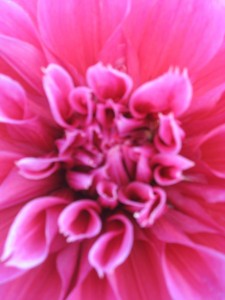 That, to my mind, is exactly the purpose a dahlia serves in the garden. This is the time of the year when your usual guest list of perennials begins to thin. The monarda have wilted. The shasta daisies are past their peak. The Japanese anemone and turtleheads won’t be making an appearance for another week or so. Unsightly vacancies suddenly form in the long border’s seating plan. You can always make do with annuals — geraniums or snapdragons, say — but isn’t there something a little too loud and obvious about them? Dahlias, on the other hand, have the look and feel of a first-class perennial (though they are essentially tubers) combined with the flexibility of a bulb. Could your tired old peony bush use a fresh new face at its side? Hello, darling, let me introduce you to my dear friend Mr. Dahlia.
That, to my mind, is exactly the purpose a dahlia serves in the garden. This is the time of the year when your usual guest list of perennials begins to thin. The monarda have wilted. The shasta daisies are past their peak. The Japanese anemone and turtleheads won’t be making an appearance for another week or so. Unsightly vacancies suddenly form in the long border’s seating plan. You can always make do with annuals — geraniums or snapdragons, say — but isn’t there something a little too loud and obvious about them? Dahlias, on the other hand, have the look and feel of a first-class perennial (though they are essentially tubers) combined with the flexibility of a bulb. Could your tired old peony bush use a fresh new face at its side? Hello, darling, let me introduce you to my dear friend Mr. Dahlia.
I think dahlias have an unfair rep for being difficult to grow and maintain. But once you get the hang of their little quirks and habits you’ll find that their remarkable variety and vigor, including blooms that last right up to first hard frost, make up for any of these idiosyncrasies. Originally from Mexico, dahlias are subtropical which means that, in our area, they need to be lifted at the end of the season and stored in a bed of peat moss in a cool dry frost-free spot. And they’re fast growers, so they should be staked when they’re planted to support their prodigious size (mine often shoot up past four feet!) and munificent blooms. You might read about their need for extra compost, watering, pruning , etc., but once I plant my tubers in early May, they’re on their own. And my dahlias seem to thrive under this regime of benign neglect.
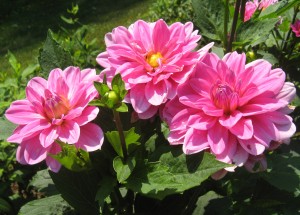 And there’s a lot more good news! Though I’ve become particularly fond of the decorative double-flowered dahlia in shades of pink and purple (pictured here), there are hundreds of dahlia types, tints, and colorings — from miniature pompons to enormous dinner plate varieties whose flowers can grow up to 14 inches in diameter. Though some have been developed specifically for cut flowers, I find that most dahlias lend themselves beautifully to bouquets, keeping their shape and color long after the cosmos and zinnias have wilted.
And there’s a lot more good news! Though I’ve become particularly fond of the decorative double-flowered dahlia in shades of pink and purple (pictured here), there are hundreds of dahlia types, tints, and colorings — from miniature pompons to enormous dinner plate varieties whose flowers can grow up to 14 inches in diameter. Though some have been developed specifically for cut flowers, I find that most dahlias lend themselves beautifully to bouquets, keeping their shape and color long after the cosmos and zinnias have wilted.
Try introducing a dahlia or two into your garden next spring and you’ll discover a delightful (and lucrative) bonus at the end of the season when you lift them for storage: the plant will have produced a half dozen or more new tubers just like the one you started with. Suddenly, you’ll have lots of extra “extra men” to help perk up your late summer garden next year!
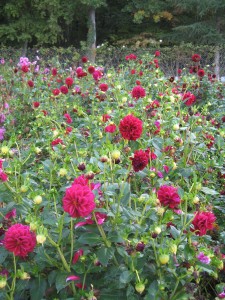
Dahlias in the cutting gardens of Château de Chenonceau, France
Tips for gardening with dahlias:
• They’re sun-worshippers. Though they’ve done well for me in spots with afternoon shade, for maximum blooming they need lots of sunshine
• Recycle your holes: My tulips are usually withering about the time that dahlias should go in (early May for me), so I lift the spent tulip bulbs and replant some of the holes with dahlia tubers (and vice versa in the fall)
• Give them plenty of elbow room: For the taller varieties, you’ll need 2 to 3 feet between them — they grow and spread out far more than you can imagine when you’re planting them as 6-inch tubers.
• They like being pinched: Promote side growth and more flowers by pinching out the center shoot when the plant is well established.
• They’re easily hurt when you’re cutting them for flower arrangements, so make sure not to bruise the stems. Cut them with a sharp knife rather than scissors and at a 45-degree angle for maximum water intake.
• Consult the experts. The American Dahlia Society has a wonderful web site which tells you everything you need to know about the “growing, showing, and enjoyment of dahlias in North America.” https://www.dahlia.org/







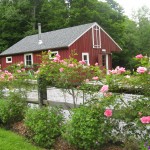

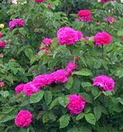
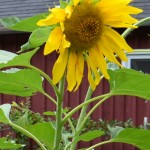

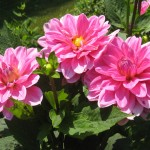




I love the analogy.
Why,Liza, do they look forlorn in flower markets.? Are they “wild at heart”
and are not cut the way you described and therefore longing for water?
I love the pink and purple ones you photographed.
Your photographs are as lovely as the botanical garden in Edinburgh with
the wild Tibetan poppy- thanks! Margaret
Thank you, Margaret. I’m not sure why they wilt, though it probably does have something to do with them being tubers. I just cut five or six dark purple ones and gave them some cosmos for company. If I’m lucky they’ll last for a day or two — but I think they’re also beautiful as they fade.